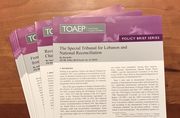Table of contents:
Element:
ICTY
In the Dorđević Appeals Judgement, the Appeals Chamber held that:
"While the Appeals Chamber has not expressly considered the terms "meurtre" and "assassinat", the case law of the ICTY has been consistent in not requiring premeditation as one of the elements of the crime of murder either as a violation of the laws or customs of war or as a crime against humanity. The elements of the crime of murder as a war crime pursuant to Article 3 of the Statute have been established by the ICTY Appeals Chamber as follows: (i) the death of a victim taking no active part in hostilities; (ii) the death was the result of an act or omission of the perpetrator(s) or of one or more persons for whom the accused is criminally responsible; and (iii) the perpetrator intended to kill the victim or wilfully harm or inflict serious injury with reasonable knowledge that the attack was likely to result in death. These elements have been established to be identical to those required for murder as a crime against humanity under Article 5 of the Statute, with the exception that the general chapeau requirements for each be met."[1]
The Trial Chamber in Orić held that:
"Intent to kill is required in order to fulfil the mens rea of murder. This includes proof of a mental state wherein the perpetrator foresees as more likely than not that the death of the victim could occur as a consequence of his act or omission, and he nevertheless accepts the risk. Negligence and gross negligence do not satisfy the mens rea requirement. Further, premeditation is not a mens rea requirement."[2]
In Martić, the Trial Chamber stated that:
"The mens rea of murder is the intent to kill, including indirect intent, that is the knowledge that the death of the victim was a probable consequence of the act or omission. This Trial Chamber does not consider it to be sufficient that the perpetrator knew that death would be a possible consequence of his act or omission. In connection with the identity of victims, it is not required for the perpetrator to have intended to target a certain individual; indiscriminate intent to kill whoever is fatally injured as a result of his action is sufficient."[3]
In the Lukić and Lukić case, the Trial Chamber explained that:
"Rather, it is sufficient that the perpetrator intended indiscriminately to kill whoever would be fatally injured as a result of his action."[4]
ICTR
As stated by the Trial Chamber in Ndindiliyimana et al.
"Murder is the unlawful, intentional killing of a human being. There is no requirement that the killing be premeditated, only that the killing be intentional."6.a. [Mental element for Element 5] [Conduct of killing]: The perpetrator meant to kill one or more persons.
[5]
Prosecutor v. Édouard Karemera et al., Case No. ICTR-98-44-A, Judgement (AC), 29 September 2014, para. 670:
"670. The Appeals Chamber recalls that the mens rea for murder as a serious violation of Article 3 common to the Geneva Conventions and of Additional Protocol II is the intent of the accused or of the person or persons for whom he is criminally responsible to kill the victim or to wilfully cause serious bodily harm which the perpetrator should reasonably have known might lead to death. In the legal findings section on genocide, the Trial Chamber explained the basis of its findings that Ngirumpatse and the physical perpetrators of the killings acted with genocidal intent. The Appeals Chamber considers that these findings equally provide the necessary reasoning and basis for the Trial Chamber’s conclusion that the perpetrators acted with the intent to kill."
SCSL
The Fofana and Kondewa Trial Chamber found:
"We find that individuals were intentionally killed; in the majority of cases they were specifically targeted because of the perpetrator' s belief that they were 'collaborators' or rebells." "[6]
Footnotes:
[1] ICTY, Dorđević Appeals Judgement, 27 January 2014, para. 548.
[2] ICTY, Orić Trial Judgment 30 June 2006 para. 348. (footnotes omitted).
[3] ICTY, Martić Trial Judgment 12 June 2007 para. 60.
[4] ICTY, Lukić and Lukić Trial Judgment , 20 July 2009, para.903.
[5] ICTR, Ndindiliyimana et al. Trial Judgment 17 May 2011, para. 2143 (footnotes omitted).
[6] SCSL, Fofana and Kondewa Trial Judgment, 9 October 2007, para. 787.







